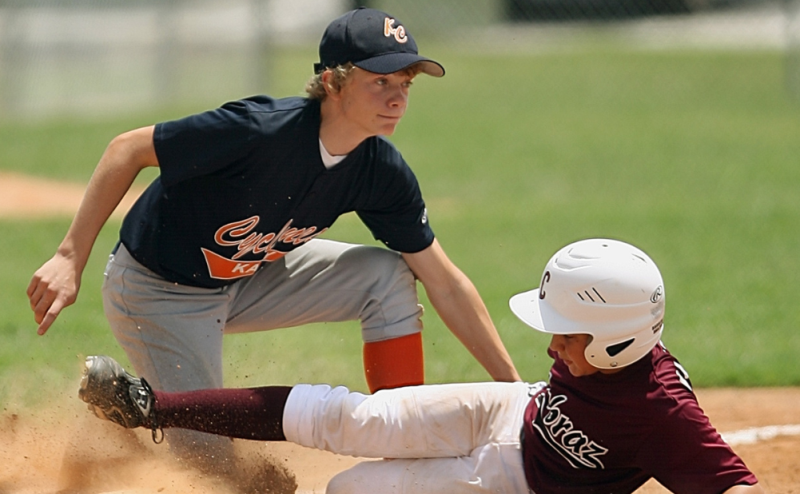Being a five tool player means that you’re great at five different parts of the game. Typically, these are contact, power, fielding, throwing, and running.
These are all important pieces of making a great player, but we are going to focus on strength, agility, and speed.
For the purposes of this blog, “strength” will mean batting power rather than arm strength. Agility isn’t a “tool” of its own, rather a tool that significantly impacts multiple facets of the game.
Agility changes ability to play defense – stopping quickly, changing directions quickly, etc.

Finally, speed is its own tool, but also impacts defense significantly. Speed = range.
I’d like to start by pointing out that you shouldn’t be working towards a maximum lift with these workouts.
In the research that I’ve looked at, it is best to either work at 50% of your one rep max or use resistance bands so that you can adjust the workout accordingly.
I’m personally a big fan of plyometric workouts as well. My goal is to offer specific lifts that anyone can use.
Remember, these are exercises, not a full workout plan.
Strength
Using weights:
Squats: This is your typical squat. Place, about, 50% of your max onto the bar. Start by lowering your body until your legs are parallel to the ground. Then rise back up. Do four sets of ten reps.
Rotating med ball throws: This exercise is best done with a partner and involves you using a weighted medicine ball. You take the med ball twist to the right and pass the ball to your partner. Then twist to the left to receive the ball. Alternatively, you can do this by throwing the med ball against a concrete or brick wall. 4 sets of 10
Farmer’s walk: This is an incredibly simple workout. You grab a 45 pound weight in each hand, then carry the weight by the edges.
Try to make it across the room and back. Take a 30 second break, and repeat two more times. This “lift” allows you to work on your core (back), lower body and grip strength.
Plyometric: Plyometric exercises use your body weight instead of actual weights.
Squats: First, you can do your typical squat (mentioned above). I also highly recommend jumping squats; where you explode (jump) out of the squat and, literally, jump into the air.
This will increase explosion and power in your legs. I do not recommend jumping squats using added weight.
Clapping pushups: Get in a normal push up position. Lower yourself down, then push off of the ground with as much force as possible.
In doing so, you want to use your arms to essentially “jump” off the floor and clap your hands, then return to push up position. These can be pretty tough.
When starting out, I’d make my goal three sets of five. You can progress from there.
Planks: Ah, the dreaded planks. They’re so simple, yet so difficult. Start in push up position. Then move down so that your body weight is on your forearms instead of your hands.
This seems pretty simple, but it can be very difficult. Try to maintain this position for 30 seconds at a time.
The first few times you try this, you should do three sets. You can start to increase after that. You can progress to alternating shoulder touches with time.
Agility
Agility ladder:
An agility ladders are great. They’re cheap and allow you to do a variety of different agility drills.
If you don’t have an agility ladder you can draw one out on concrete or even paint one on grass.
I believe this is the best tool you can purchase or create when working on agility drills.
Side straddle and hop: Start by standing at the end of the ladder, and jumping with both feet in a square, then straddling the square.
You progress to the next square by jumping forward and placing your feet back on the inside. Repeat until you’re at the end of the ladder. Then repeat three more times.
Carioca runs focus on change of direction. You alternate between squares my facing forward, stepping into the next square and facing sideways, then moving into the next square facing forward.
Many athletes only do this facing one direction. In four “reps” of the ladder, you should alternate sides.
So, in completing the ladder four times, you’re facing right twice and left twice.
In & Out is a great pattern where you start on the outside of the ladder facing the middle. You progress through the ladder by stepping into a square with both feet, then out of the square with both feet.
Step into the next square with both feet. So, you are actually progressing sideways as you move down the ladder.
River dance is a unique pattern that focuses on hip flexibility. You start by standing outside of the ladder, facing straight ahead.
Take a step forward, into the ladder. Then take your outside food, move it behind you and to the opposite side of the ladder.
Repeat moving toward the end of the ladder in an inside, behind, outside type pattern.
Dot drills:
Dots have become very popular. You set out five dots in a two one two pattern.
Every exercise can follow a few simple patterns. Imagine drawing a picture as you move across the dots. The pictures that you should be trying to create are a square, an hour glass, and an X.
My suggestion is to try all of those movements with a two-foot jump (keep your feet very closely together; almost as if they were tied), a right-footed jump, and a left-footed jump.
You should try to go through each pattern for at least 30 seconds. Your goal should be to maintain form and increase speed over time. I like to connect multiple patterns together.
Try starting at 60 seconds with any pattern you’d like, but make sure to switch up how you’re jumping. With time, you’ll be able to add more.
Speed
1 legged squats are great because you can do them with or without weights. Rest one leg on something (like the weight bench) to help you keep your balance.
Again, I like to do these without much weight. I typically suggest doing three sets of eight.
Split Jumps or start jumps get their name because you jump high into the air and make an X with your arms and legs. Including your head, this creates five points.
Sprints are always a great option when trying to build speed. Obviously running on the field is a great exercise. I like to also have players run on treadmills.
Treadmills work your muscles differently and force you to exercise and strengthen your calves.
This is great, because your calves play a large role in exploding into your first step.
I’d recommend that you combine treadmills and open filed running to get a balanced exercise.
Running hills is a great way to increase your speed. Hills can help build strength and increase flexibility at the same time.
Running up hill uses a shorter stride length and more strength while running down hills increases your stride length and uses less muscle.
It’s a great dual-benefit exercise. Just be careful not to move too fast when going downhill.

Hello everyone, I’m Darron and head Editor of this site. I’m so proud to be a part of this project.
